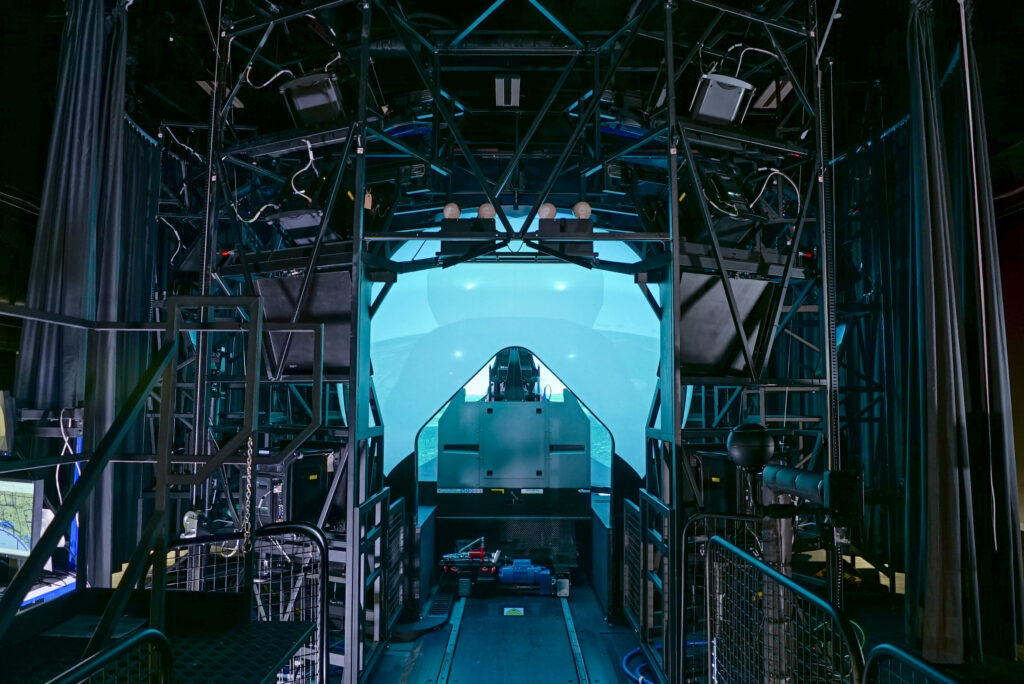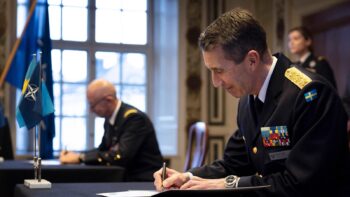
F-35 training simulator
WASHINGTON: “The principal challenge DoD faces is not a lack of innovation,” Christine Fox told Congress Tuesday. “The tougher task is how to adopt all this new innovation more rapidly into DoD programs….We have lots of prototypes but what we need is sustainable programs.”
Fox, the former head of the Pentagon’s powerful Cost Assessment & Program Evaluation (CAPE) unit, was testifying to the first-ever hearing of House Armed Services’ newest subcommittee, Cyber, Innovative Technologies, and Information Systems. The topic of the day was innovation – but Fox and her fellow acquisition experts on the panel made clear that having lots of neat ideas was far from enough.
They offered lots of concrete suggestions on how the Defense Department could get innovative ideas across the “valley of death” that separates one-offs that look good in the lab from mass-produced weapon systems that work in the field.

Christine Fox
One major past reform arguably made that harder: the division of the office for Acquisition, Technology, & Logistics into two separate undersecretariats, one for Research & Engineering and the other for Acquisition & Sustainment.
Having a separate R&E organization focused on innovation has real benefits, Fox said, but it also makes it harder to hand-off new technologies to the A&S side to turn them into mass-produced programs of record. On balance, she said, “perhaps it has exacerbated the key problem… the adoption of technology.”
Former DARPA director Victoria Coleman put it more bluntly: “Unfortunately, the split has created almost a fracture,” she said, in what should be an unbroken “continuum” from new idea to fielded product. That doesn’t mean we should re-merge R&E and A&S, she said, because there are very real differences in the skillset and organizational focus required to launch a new technology on the one hand and to mass-produce it on the other. But, she said, “it’s probably time we should review [and] see whether we should tweak aspects of it.”
 Software Over Hardware
Software Over Hardware
The other recurring theme that stood out most strongly at the hearing? Focus on software first, hardware second.
Subcommittee chairman Jim Langevin hit this point in his opening remarks, calling for the Pentagon to treat the F-35 Joint Strike Fighter and the sixth-generation fighters to come after “not as hardware platforms, but as flying computers, wrapped in an airplane.” (Breaking Defense readers will recall the constant struggles to update the F-35’s millions of lines of code, especially the crucial Mission Data Files).
That software-first approach should apply to warships and other big-ticket platforms as well, Fox added.
“It’s all about the software,” agreed Coleman. And indeed the Pentagon has plenty of small, smart software shops such as the Air Force’s Kessel Run. But, she argued, what’s lacking is an institutional mechanism to systematically turn those software innovations into enduring programs.
“We have wonderful examples like Kessel Run,” Coleman told the subcommittee. “What we don’t have today however is this concept of product management.” That, she explained, is the private-sector best practice in which coders get together every few weeks with the acquisition executives who can give them guidance and resources to help turn their software into a usable product.
Today, she said, “there’s no DoD component that does that function.”
Another Silicon Valley practice to borrow, Coleman said, is venture capital. Recent financial reforms, including at the interagency Committee on Foreign Investment in the United States (CFIUS), successfully blocked many Chinese-backed venture capital firms from snatching up American innovations. But not enough American and allied capital has stepped up to fill the gap, leaving many start-ups desperate for funding the Pentagon could help provide.
“Houston, we have a problem,” Coleman said. “We need to do something to [replace] the Chinese capital that left town.” She tried this on a small scale at DARPA, with a $35 million “national security seed fund” – “a drop in the bucket,” she acknowledged – but what’s necessary is a systematic DoD effort “to make trusted capital available to small businesses.”
Another way to move the necessary capital, added Hill and Intelligence Community veteran Klon Kitchen, might be to make software companies the prime contractors on major weapons programs, with hardware-focused firms as subcontractors. That’s the opposite of how it’s traditionally done, where hardware companies are the primes and software funding is tucked in various places across larger programs. Innovative firms don’t need lots of little investments, Kitchen said, but substantial contracts that can be scaled into enduring programs of record.
To get innovators on board, Kitchen added, “the Pentagon’s also going to have to reconsider its one-size-fits-all approach to intellectual property.” Innovative private-sector software firms live or die by their trade secrets, making them deeply reluctant to hand them over to the Defense Department to the extent traditional contracting arrangements often require.
You also need to help innovative firms – especially smaller ones – protect their IP against espionage, Fox said. The Pentagon should provide “a mechanism to plug in securely,” she argued, probably through some kind of high-security cloud computing architecture.
Once you’re properly focused on software over hardware, Fox argued, you can make your program much more flexible, adaptable, and easy to upgrade over time. You do that, she said, by making them “modular… from the very beginning.” This approach, known more formally as modular open systems architecture, is basically the Lego approach to weapons system design. You establish strict technical standards for how different subsystems (modules) fit together, but as long as companies meet those standards, they can innovate however they want, allowing you to plug-and-play a wide range of different components as new technologies become available.
Pentagon announces new reciprocity guidance to streamline software adaptation
“We’ve heard you loud and clear on this within the DoD. I’m not going to say this is going to solve every bit of it, but it’s going to help us a bit,” Pentagon CIO John Sherman said.



























